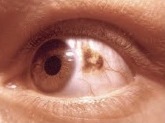
Photo from wikipedia
Objective: This study aimed to develop a validated machine learning model to diagnose small choroidal melanoma. Design: This is a cohort study. Subjects, Participants, and/or Controls: The training data included… Click to show full abstract
Objective: This study aimed to develop a validated machine learning model to diagnose small choroidal melanoma. Design: This is a cohort study. Subjects, Participants, and/or Controls: The training data included 123 patients diagnosed as small choroidal melanocytic tumor (5.0–16.0 mm in largest basal diameter and 1.0 mm–2.5 mm in height; Collaborative Ocular Melanoma Study criteria). Those diagnosed as melanoma (n = 61) had either documented growth or pathologic confirmation. Sixty-two patients with stable lesions classified as choroidal nevus were used as negative controls. The external validation dataset included 240 patients managed at a different tertiary clinic, also with small choroidal melanocytic tumor, observed for malignant growth. Methods: In the training data, lasso logistic regression was used to select variables for inclusion in the final model for the association with melanoma versus choroidal nevus. Internal and external validation was performed to assess model performance. Main Outcome Measures: The main outcome measure is the predicted probability of small choroidal melanoma. Results: Distance to optic disc ≥3 mm and drusen were associated with decreased odds of melanoma, whereas male versus female sex, increased height, subretinal fluid, and orange pigment were associated with increased odds of choroidal melanoma. The area under the receiver operating characteristic “discrimination value” for this model was 0.880. The top four variables that were most frequently selected for inclusion in the model on internal validation, implying their importance as predictors of melanoma, were subretinal fluid, height, distance to optic disc, and orange pigment. When tested against the validation data, the prediction model could distinguish between choroidal nevus and melanoma with a high discrimination of 0.861. The final prediction model was converted into an online calculator to generate predicted probability of melanoma. Conclusions: To minimize diagnostic uncertainty, a machine learning-based diagnostic prediction calculator can be readily applied for decision-making and counseling patients with small choroidal melanoma.
Journal Title: Ocular Oncology and Pathology
Year Published: 2021
Link to full text (if available)
Share on Social Media: Sign Up to like & get
recommendations!